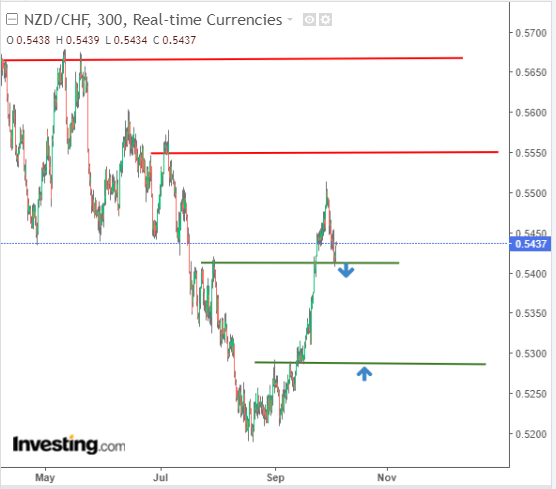- Is EUR/USD Preparing for Another Corrective Move?
- USD/JPY Currency Intervention Fails to Halt Yen Depreciation
- Possible Conclusion of the NZD/CHF Rebound
The advent of autumn in the currency markets brings with it sustained volatility, primarily influenced by the actions of central banks to combat stubbornly persistent inflation.
The notable exception among the world's major central banks is the Bank of Japan, which has steadfastly maintained negative interest rates, leading to a renewed decline in the Japanese yen, approaching the 150 yen per dollar threshold once again.
Another currency pair worth monitoring is NZD/CHF, where the possibility of the corrective phase coming to an end arises after the Reserve Bank of New Zealand opted to maintain its current stance of no further interest rate hikes.
EUR/USD Experiences Third Consecutive Month of Downtrend
Meanwhile, the key currency pair EUR/USD has been on a southward trajectory since mid-July. This is attributed to the likely conclusion of the European Central Bank's interest rate hike cycle, while the Federal Reserve remains open to further rate hikes, which has reflected on bond yields, thus brining hungry carry traders into the paring.
Loretta Mester, the head of the Fed's Cleveland branch, a leading advocate for hawkish policies, recently emphasized a high likelihood of another 25bp rate hike this year. In light of this divergence, EUR/USD is under pressure, with the potential for further declines.
However, the demand side has currently initiated a local correction, the completion of which may serve as the catalyst for another leg of downward movement.

An intriguing development to watch for would be a potential rebound toward the confluence of the correction equality and the supply zone positioned in the price vicinity of $1.0570 per euro.
On the downside, the scenario anticipates a possible assault on the next support area, which hovers just below the key level of 1.04.
USD/JPY Attacks 150 Resistance Again
Sustaining the current policy of yield control is becoming increasingly expensive for the BOJ. This became evident in Wednesday's emergency auction, where a total of $4.52 billion worth of 10-year Treasury bonds were offered, but failed to halt the rise in yields, which reached their highest levels in over a decade.
As a result, the Japanese yen depreciated. Despite a likely intervention and a temporary dip to 147 yen, it couldn't suppress the upward momentum on USD/JPY. Currently, the pair has entered a phase of local consolidation, and a breakout to the upside is expected to mark the beginning of a renewed assault on the psychological barrier of 150 yen.

Considering that a sustained breach of the 150 yen mark may be deemed unacceptable by the Bank of Japan authorities, additional currency interventions are highly probable.
NZD/CHF: Is the Correction Coming to an End?
Over the past month, the exchange rate of the NZD/CHF currency pair has exhibited a relatively robust reversal of its long-term downtrend.
The deceleration in this growth could potentially signal the start of another downward phase, especially in light of the recent Royal Bank of New Zealand meeting, which was perceived as dovish due to the decision to maintain the current stance with no further interest rate hikes.
However, it's worth noting that the demand impulse dynamics may pose challenges, as they do not align with a conventional corrective pattern.

A strong supply signal will occur if the support level at 0.54 is breached, which will open the path for an attack on targets that are already positioned below 0.53. If the correction extends further, it will lead to a test of the supply zone near 0.555.
***
Disclosure: The author holds no positions in the instruments mentioned in this report.


